This is the course notes I took when studying Introduction to Marketing, offered by Wharton on Coursera.
- Marketing 101
- Strategic Marketing
- Brand Positioning
- Customer Centricity
- Go To Market Strategies
- Brand Communication
- Brand Repositioning
This course covers three core topics in customer loyalty:
- Branding: brand equity is one of the key elements of keeping customers in a dynamic world in which new startups are emerging constantly.
- Customer centricity: not synonymous with customer service, customer centricity starts with customer focus and need-gathering.
- Go-to-market strategies: understand the drivers that influence customers and see how these are implemented prior to making an investment.
Marketing 101
The essence of marketing is to have a very strong brand.
A market is an exchange between two partners, frequently a buyer and a seller, but it also applies to non-profit transactions. What marketing means is going to differ as a function of different aspects of those exchange. The two extremes of exchanges are buyer’s market and seller’s market.
The seller’s market means the seller has a product, and if you want that product, you have to come to the seller. So the seller has all the power. It is product-focused market and the objective is to sell as much as you can, and profitability comes from market share (higher revenue, lower average cost). The growth comes from new products based on your product experience and new markets.
The buyer’s market has lots of competition, a lot of products out there, and the buyer has the power. Marketing focuses on customer and competition and creates the best product that meets customer needs so that they buy from you instead of the competitors. It is too difficult to develop products for every single customer, so your customer segment is important in customer-focused marketing. The profitability comes from increased price premium, delivering value over time (“loyalty”) at often lower cost (it’s more expensive to acquire customers than delivering goods over time through loyalty) and selling other things to the same customer through “cross-selling”. In short, profitability comes from “customer share” (get more from each customer).
Due to social media, internet, and globalization, customers talk to customers about their experience about the transactions. Marketing in such a “connected community” world focuses on customer experience.
Due to economic recession and scandals, marketing also needs to focus on gaining customer trust.
| Orientation | Production Orientation | Marketing Orientation | Experience Orientation | Trust Orientation |
|---|---|---|---|---|
| Differentiator | Persuade customer to want what the firm offers | Persuade firm to offer what the customer wants | Manage customer’s entire experience with the firm | Prioritize building a relationship of trust and discipline |
| Product focus | Generic Products | Differentiated Product/Services | Experiential Value | Genuine Value |
| Competitive Advantage | Lowest Cost | Quality and Service, Customer Knowledge | Transformation; customer as co-creator of value | Trust |
| Profitability Drivers | Market Share | Customer Share and Customer Loyalty | Buzz, Word-of-Mouth, Referrals | Discipline |
The 3 principles of marketing:
- Principle of Customer Value: if you want to provide something to a customer, to a buyer, and get them to buy from you rather than the competition, you’ve got to give them real, genuine customer value.
- Principle of Differentiation: You have to provide customer value to that customer, what the customer wants, but you have to do it better than the competition (i.e., differentiate the offering).
- Principle of Segmentation, Targeting, and Positioning: when you’re in a customer focused market, you cannot deliver value to everybody and make money, it’s just too difficult to do. So what you do is segment the market into different segments. You target or choose a segment you want to focus on, and you position your brand to meet the needs of that target segment.
The 4 P’s of Marketing are the tools to deliver these three marketing principles:
- Product (what the seller puts into the exchange)
- Place (the way the seller delivers the product to the customer)
- Promotion (the way the seller communicates the benefits about that product to the buyer)
- Price (what the buyer puts into the exchange)
Strategic Marketing
It is a framework to figure out how to think competitively and become a leader in the market. The framework is based on a set of strong principles, or assumptions:
- Know your markets. You know what your customers want. And furthermore, you know how your competitors are likely to react.
- Customers have the final say. When comparing products, because there are so many factors, customers bundle factors into three categories: operational (e.g., price and delivery), product features and designs, and customized to my need. Customers assign scores to each category, identify the most important category, and find the product that performs the best in this category while being good enough in others.
- Commit to being first in the market you serve. Being the best in your chosen category while good enough in other categories should be your market strategy.
A value map is the relation between relative cost to the customer and relative perceived benefit. The fair-value line is the fair cost for a given level of benefit.
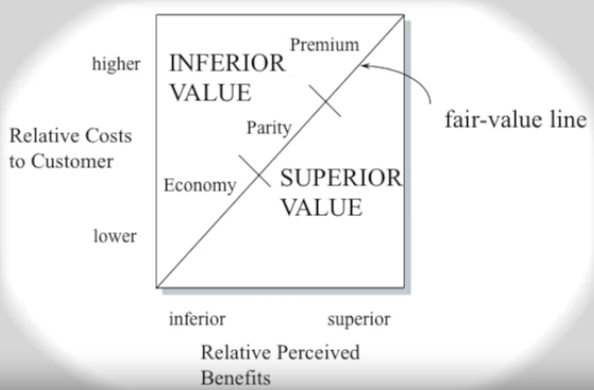
The area above is inferior value and the area below is superior value. The fair value is not constant; it changes as the market competitiveness changes over time.
The framework is as follows:

The three bundles:
- Operational Excellence;
- Performance Superiority;
- Customer Intimacy.
The crosshatches are fair value lines. Note that the three bundles don’t have to be symmetric. The framework involves the following steps:
- Map product attributes to each bundle.
- Anticipate the fair value points. These should be the customer expectation, not the average of what everybody offers (because the industry could under- or over-perform as a whole). This is the trickiest in the framework.
- Determine where the company is on each axis relative to the fair value.
- Figure out where your competition is on each axis.
- Put together the short-term strategy (what should you be doing right now in order to beat the competition?) and long-term strategy (to be the best at one dimension and good enough on the other two).
- Implement the strategy in your firm.
Brand Positioning
Brand positioning is a critical idea in marketing. The positioning process is called the STP framework: Segmentation, Targeting, and Positioning.
- Segmentation: identify variables that allow one to segment the market;
- Targeting: evaluate the attractiveness of each segment and choose a target segment;
- Positioning: identify positioning concepts for each target segment, select the best, and communicate it.
Segmentation and Targeting
Market segmentation is the process of dividing a market into distinct subset, where any subset can conceivably be selected as a marketing target to be reached with a distinct marketing mix (4 P’s). Segmentation methods include:
- Characteristics of the customer (e.g., demographics): such as cohort analysis (baby boomers vs. millennials), geographic segmentation like regional segmentation, zip clustering (rich neighborhoods across the US);
- Benefits sought;
- Systematic, product-related behaviors (e.g., purchasing behavior like online vs. in store).
To select a target segment, we must balance segment attractiveness with our capability to deliver to the segment, and continuously monitor whether the actual buyers match the target segment. Criteria include:
- About segment:
- segment size;
- growth of segment;
- value of segment;
- stability;
- About the company:
- current company position within the segment;
- ease of entry into segment;
- About competitors:
- ease of competitive entry into segment;
- number and strength of competitors.
Develop measures of segment attractiveness and select among attractive segments based on business capabilities.
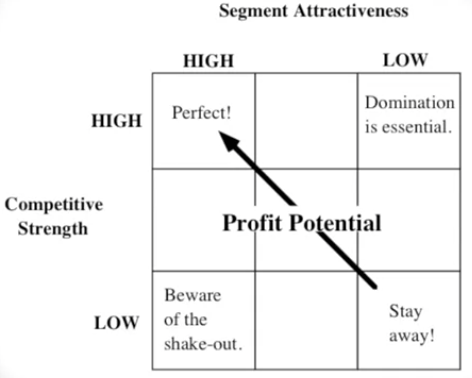
Brand Positioning
Brand, formally, is a proprietary trademark for a specific product or service. Conceptually, brand is a “contract” from the company to its customers; a promise of specific benefits, quality, and value; a relationship. In today’s connected community, brand is what customers think it is and tell each other it is.
A positioning statement defines the value proposition of product to the target market. It consists of:
- Target segment (for whom).
- Point of difference (differentiator to competitors and reason to buy).
- Frame of reference (other competitors, or called points of parity).
The point of difference is relative to the frame of reference. Positioning should
- focus on a few key benefits;
- be defensible from your competitors;
- require making choices in all three areas. You cannot have everything for every segment.
Point of Parity (POP) is associations that are not unique to the brand; they are shared with other brands (because it is a relative, comparative measurement). For example, category POPs are associations customer views as necessary to be considered credible, such as diary in a grocery store, and competitive POPs are associations designed to negate competitors’ point of difference, such as fluoride in every toothpaste.
Point of Difference (POD) is similar to the notion of unique selling proposition. It should be strong, favorable, unique brand associations. It should be the sustainable competitive advantage (SCA) in order for the positioning to be defensible; that is, to achieve an advantage in the marketplace for a prolonged period of time. POD may involve: performance attributes, benefits, imagery associations. Good POD should be
- desirable to the customer: relevant and distinctive;
- possible to deliver to the customer: feasible, communicable, sustainable over time.
Brand Mantra: the Elevator Speech
You can have a lot of ideas about positioning, but it is hard to hone in to the right choice and come up with a precise and crisp brand mantra.
A mental map, or semantic associative network, can develop a picture of the thought and associations that come up with the brand. It portrays branch associations and responses for a target market, and shows how it is actually perceived. A mental map of McDonald’s can look like this:
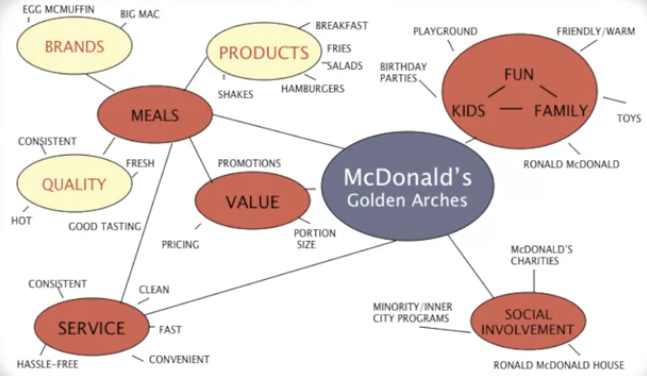
After doing mental maps for multiple customers, find the set fo abstract concepts or phrases that Characterize the five to ten most important dimensions of the mental map of the brand (i.e., core brand values), relate them to points-of-parity and points-of-difference, and come up with the brand mantra.
Brand mantra is the articulation of the “heart and soul” of the brand, short three- to five-word phrases that capture the irrefutable essence or spirit of the brand positioning and brand values. It is known by customers and employees and is everywhere. It has three parts:
- The brand function describes the nature of the product or service or the type of experiences or benefits the brand provides.
- The descriptive modifier further clarifies its nature.
- The emotional modifier provides another qualifier - how exactly does the brand provide benefits, and in what way?
Brand mantra can describe what a brand does and also what a brand is not.
Experiential Branding
In a connected community world, customer experience is vital. You have to define the experience around the brand besides the brand positioning.
Experiences are processes that occur as a result of encountering, undergoing or living through situation (it’s continuous). They are triggered stimulations to the senses, heart, and mind. They connect the company and the brand to the customer’s lifestyle and place individual customer actions and purchase occasions in a broader social context.
Experiential brand positioning is
- what the brand stands for;
- should be a multi-sensory strategy;
- should be different in some real and valuable way from all competitors.
Experiential brand value promise describes what customers get in experiential terms: sense, feel, think, act, and relate.
Experiential components are:
- Five senses: consistent experiences across senses. It creates a sensory experience that extends across channels.
- Emotions: appeals to customers’ inner feelings and emotions.
- Cognitive: appeal to the intellect, engage customers creatively, problem-solving experiences; use of surprise, intrigue and provocation.
- Behave: affect bodily experiences and lifestyles, enrich customer lives; show them alternative ways of doing things, alternative lifestyles. It can be rational but also motivational, inspirational and spontaneous.
- Social: create feeling of community or belonging; the “future ideal” self that consumer wants to relate themselves to.
Experiential value are delivered through 4 P’s:
- Product: build in experiential features (e.g., Apple);
- Place: store/website design, music, fragrance, type of salespeople (e.g., Sephora);
- Promotion: noteworthy, experiential “brand personality”;
- Price (e.g., eBay’s auction, Priceline’s bidding).
Summary
| Strong Brands | Weak Brands |
|---|---|
| Make clear promises that are kept over time | Make vague promises that change |
| Have rich, unique brand equity, strong thoughts and feelings | Very general equity and low emotional commitment |
| Are dependable and deliver consistently | Have “spotty” reputations, create doubt |
| Have a loyal franchise | Little loyalty, rely on pricing and short-term promotional incentives |
Other characteristics of great brands include:
- Consistency in delivering on their promise;
- Superior products and processes;
- Distinctive positioning and customer experience;
- Alignment of internal and external commitment to the brand.
Customer Centricity
In strategic marketing, one bundle is customer intimacy. This section focuses on it, or called “customer centricity”.
The goal of a firm is to maximize shareholders’ value. Maximum profits through volume and cost reduction. One key performance indicator is market share, which not only is a indicator of the present, but also of the future. Such metrics, like market share and others, are central to this product superiority, or operationally excellent strategy. Shareholders demand growth. Growth can be achieved through extending the product, either through bringing existing ones to new market, or by creating new ones. Companies are organized by product. And thus, the competitive advantage of an organization or a company is product expertise. This is the traditional, product-centric way of business.
While product centricity is not doomed to fail, there are trends that don’t exist 15 or 20 years ago that reduces the chance of success of it:
- Commoditization: technology-driven product development that shortens the product lifecycle.
- Smart customers: technology-driven information flows make customers aware of existing and new product options and put more demands on companies.
- Retail saturation: technology-driven delivery that makes more products available to more customers in more locations.
- Globalization.
- Deregulation.
- Customers want end-to-end solutions. Companies act like trusted advisors. One example is IBM, once a product-centric company, moves to provide solutions by selling its hardware businesses.
- Information systems enable customer-level tracking and thus data-driven business models.
Direct Marketing
Direct marketing is an advertising strategy that relies on the individual distribution of a sales pitch to potential customers. In other words, the individual customer is the unit of analysis. It tries to know who there customers are and what they buy, aim to determine marketing communication based on past purchases, and constantly determine (and leverage) individual customer value.
Any company that’s operating on the internet, any company that has the capability to track a particular customer over time are using direct marketing.
Customer Centricity
Customer centricity is a strategy that aligns a company’s development/delivery of its products/services around the current and future needs of a select set of customers in order to maximize their long-term financial value to the firm.
Customer centricity requires the company to be willing and able to change its organizational design, performance metrics, and employee/distributor incentive structures to focus on this long-run value creation/delivery process. For example, the performance metrics for salespeople should not be monthly/quarterly revenue, but long-term value increase of customers so that customers create more value in the company in the long run.
It is important to recognize that the overarching goal for customer-centric companies is still to maximize shareholders’ value. But the customer-centric world embraces customer heterogeneity: not all customers are equal, some customers are more profitable than others. When we talk about profitability, we focus on future profitability (customer lifetime value) rather than past profits. We need to use models and technology in order to project the future value of our customers.
Success arises through enhanced (and/or more efficient) customer acquisition, retention, and development. The competitive advantage is the “relationship expertise” with respect to focal customers (that cannot be commoditized).
However, customer centricity does not suggest that “non-focal” customers should be ignored or “fired”. To the contrary, it is important to have a healthy portion of such customers to add a high degree of stability and robustness to the overall customer base (like bonds in an investment portfolio). Taking this idea future, there is a paradox of customer centricity: the more that a firm tightens its central focus on a select group of customers, the more it needs its “non-focal” customers to stabilize the overall mix.
To move to customer centricity, below are important questions:
- Who is the customer? Can your organization come up with a single, consensus answer to this question, or can you at least reconcile the roles/relationships of the different potential customers?
- What are the major barriers to move to customer centricity, and what resources can you utilize to overcome these barriers.
- What competitors are doing in this area? Is it better for everyone be customer-centric or only you?
- Does it make sense for your organization to become customer centric? If so, what should be your immediate goals and medium-term expectations?
Go To Market Strategies
To build a go to market plan, a company should do the following steps:
- Situation Analysis using 5 C’s: Context, Consumers, Company, Competitors, Collaborators.
- Strategic Positioning: evaluate different target markets and positioning options.
- Implementation using 4 P’s. And the go to market plan is promotion.
This section discusses Promotion, Price, and Place.
Promotion Strategy
Promotions Strategy can roughly be divided into Communication Strategy and Non-Communications.
Communication strategy includes:
- Mass and targeted media (TV, digital, print, outdoor billboards)
- Advertising: outbound (TV, radio) or inbound (digital, search)
- Product placement (embedded marketing): a marketing technique where references to specific brands or products are incorporated into another work, such as a film or television program, with specific promotional intent.
- Public relations: it is not free, but you don’t pay for the time and space for the communication.
- Personal and interpersonal means:
- Sales force;
- Word of mouth (offline, online, consumer-to-consumer);
- Point of purchase/in-store.
Non-communication strategy are mostly price discounts and coupons.
This module focuses on communication strategy. Developing a communication plan requires 7 M’s:
- Markets (who should I talk to? target segment?)
- Message content (what should I tell them? key benefit and positioning)
- Mission (what do we intend to achieve? e.g., awareness, knowledge, interest, trial)
- Message design (how should I say it? Creative strategy)
- Media strategy (how do I reach them?)
- Money (how much do I need to spend?)
- Measurement (was it worth it?)
The first 2 M’s, markets and message content, are part of targeting and positioning, while the rest 5 M’s are communication decisions. So there may be only 5 M’s in some marketing books.
In the marketing world, digital content is increasing rapidly, while TV is still 1/3 of the volume. But most digital marketing is done through videos, which is not so different from ads on TV.
The key principles of campaign design are not affected by media choice or media availability; instead, media choice is determined by campaign design.
Efficiency of Communications
Consumers go through the following stages when making purchasing decisions:
- Awareness;
- Interest;
- Desire;
- Action.
This is often referred as the AIDA model. The efficiency of different strategies vary by stages:
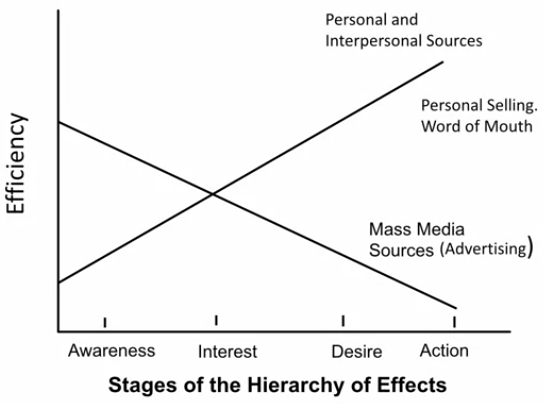
Because the efficiency is different, we should not spend all the money on that to improve awareness and interest, but also on personal and interpersonal sources. This is called the one-two punch theory of persuasion.
Message Design
Message design answers to “how do you say what you need to say”, and it has two main categories:
- Rational appeals: aim to present the point of difference or value proposition. For example,
- product demonstration explains the technology in the product and why it is superior;
- use of spokesperson makes consumers feel they could be like the spokesperson if they use the product;
- testimonial feels genuine because it comes from existing users.
- product comparison compare your own product with the competitors. It is heavily regulated so you should follow the legal guidance.
- Emotional appeals. For example,
- Use of positive emotions: affection, humor.
- Use of negative emotions: fear, must be moderate level. Too strong of fear turn people off.
Media Planning
From strategic perspective, there are three types of media:
- Paid:
- TV, search advertising, banner advertising
- Earned:
- a sponsored event or tournament;
- a campaign where you give out goods;
- Owned:
- your own website, your company building with your name;
- your own product (such as car names written on their back).
The technical aspect of media planning can be taken care of by a good advertising agency.
Money
Companies often heuristics for communication budget such as
- a percentage of sales;
- match or better than competition.
It is better to use “objectives and tasks” method, which defines the end goal of the communication and work backwards and find out what you need to spend to get there.
Measurement
There are many ways to measure the communication. However, in most times, it is not the cost of measurement (which is not high compared to the communication itself), but the willingness of measurement that blocks the measurement. So the right approach is
- decide on what the mission of your campaign is,
- set the measurement method in advance,
- and then go ahead and develop your campaign and execute it.
Digital Marketing
In the AIDA model, attention/interest/desire is to create demand, and action is to capture demand. In classic marketing, TV, billboards, newspaper ads are to create demand, and coupons, end-of-aisle displays, and shelf-talkers are to capture demand.
Digital marketing tools are more focused on capturing demand:

Pricing
Price has the highest impact on operating profit improvement, compared to fixed cost, variable cost, and sales volume, the management perception is otherwise. This suggests the use and execution of pricing can be better. Good pricing requires:
- Economics;
- Psychology;
- Statistics;
- Operational Research;
- Computer Science;
- Courage (often it is not to change the price, but to change the pricing strategy of a company);
- Common Sense.
Price Sensitivity
There are seven drivers of price sensitivity:
- Availability and awareness of substitutes. The higher the availability and awareness is, the higher price sensitivity is.
- Ease of direct comparison. Store brands (private labels) and generics are kept next to national brands to improve the ease of price comparison and drive market share.
- Expenditure (relative value in bundle)
- Total expenditure: if you spend more on a product or service, you are more price sensitive. For example, big families are more price sensitive to groceries.
- Fraction of total costs: if a particular item is a big part of your cost, you are more price sensitive.
- Shared cost (e.g., employer pays part, or medicine covered by insurance)
- Switching cost. For example, car owners are not price sensitive to gas because the cost of switching a car is much higher.
- Price/quality inferences. Perfume is one example. Other examples involves professional services, such as consulting, legal, doctor, financial advisors, and the reason is the consumer’s lack of knowledge.
- Ability of customer to carry inventory. If the customers can buy in bulk and consume later, they become more price sensitive.
Price Elasticity
Price Elasticity is defined as
\[\text{Price (demand) elasticity}=\frac{\%\text{ Change in Demand}}{\%\text{ Change in Price}}\]The use of percentage makes the measurement of elasticity not dependent on units, and thus enables comparison across industries and firms.
If the demand is elastic, the price goes up and the demand goes down, so the revenue decreases. If the demand is inelastic, the price goes up but the demand does not change much, so the revenue increases. The break-even point is elasticity of 1.
Measuring price elasticity depends on variables measured (what to measure) and conditions of measurement (how to measure).
| / | Natural | Experimental |
|---|---|---|
| Actual Purchase | Sales Data | Field/Laboratory Experiments |
| Preferences/Intentions | Survey | Trade-off Analysis (Conjoint) |
Survey asks sample groups whether they would buy the product at a given price, and assign different prices to different groups to gather the percentage of “yes” for different price points, from which elasticity can be computed. Survey is quick and not as expensive, but it has a few weaknesses:
- People often do not do what they say they will do (intention-behavior link);
- It does not explicitly account for competitor prices;
- It cannot measure repeated purchases, i.e., cannot get customer lifetime value.
Field/lab experiments change price in an controlled manner and observe sales changes.
Conjoint analysis is a survey-based statistical technique used in market research that helps determine how people value different attributes (feature, function, benefits) that make up an individual product or service.
Psychological Aspects of Pricing
- The “effect of 9 price endings” says the sales is higher with price ending in 9s than slightly higher or even lower price.
- Weber Fechner “law”: consumers react to prices in percentage terms as opposed to absolutes.
- Endowment effects: a sense of ownership increases a customer’s willingness to pay. This effect does not rely on actual ownership, but just the perception of ownership. The implication is to make consumers feel they own before they buy.
- Reference prices effect: buyers compare the current price with a reference price, which is often determined by past prices paid. One way to influence the reference price is to have a high list price or starting price.
- Context effects leads customers to the choice of the “intermediate option”. This is the foundation of “good, better, best” strategy by offering three versions of the product and most people buy the “better” version.
Conclusion: considering the psychological effects of pricing can improve profitability.
Analytic Foundations of Pricing
Margin and Contribution Analysis
Margin analysis computes how profitable a product is. While the precision in the “numerator”, i.e., profit, is important, what is strategically critical is the choice of the denominator, which should be the key binding constraint or a key resource. For example, traditional retailer’s margin is per square foot of shelf space, and law firm’s margin is per consultant hour.
Margin analysis produces a table of costs and prices for every member of the value chain (e.g., manufacturer ,channel member, end-user, etc.) for every “relevant” product (which in the product line and across competitors). It reveals everyone’s incentives in a purchase transaction, allows the discovery of potential problems, such as cannibalization and channel conflict, and provides input for subsequent analyses.
Break-Even Analysis
Break-even analysis helps to justify a change in business by calculating the increase in sales to cover the cost of the change, such as advertising and price cut. For example, how many new customers should we acquire with an additional advertising cost, or what sales growth should we expect to justify a price cut.
Cannibalization is not possible if the margin of the new product is higher. Break-even cannibalization, the percentage of customers on existing product moving to the new product, is equal to the margin on the new product divided by the margin on the existing product.
Economic Value to the Customer
Economic value to the customer, often short for EVC, is the price at which the customer is indifferent between the existing method of doing things and the new idea being proposed. It can:
- Help set a price for a new product or a service with EVC being the maximum.
- Whether or not the new idea you have is economically worthwhile. If priced at EVC and the new idea is profitable, then it is economically worthwhile.
- Targeting. Identify segments where EVC is the highest and target these segments. We can also compare Customer Lifetime Value (CLV) and EVC and gain deep understanding of the customer base.
- Who is your competition and their economic power? Who will suffer if we succeed? Analysis of EVC helps us identify where the value will migrate from.
- Re-think about how to price what you already have on the market.
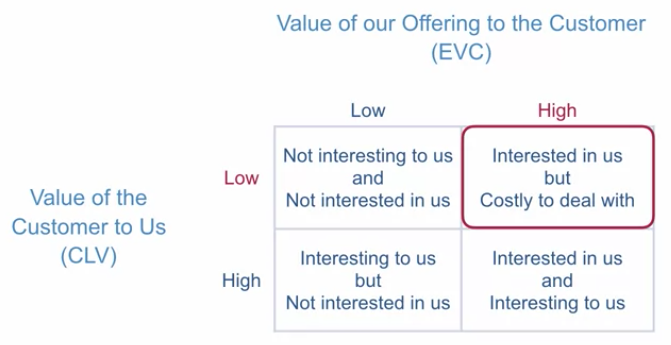
The difference between EVC and the cost of a product is shared between the inventor, the customer, and the channel partners. Price becomes a sharing rule on how much of the created value is shared. We can analyze the value for each party is high enough to make the product viable.
Customer Access
The Place in 4 P’s of marketing is to make sure your product or service is accessible to the customer at the right place, at the right time, and of the right type and quality.
Many times, a customer’s decision on what product to buy is based on their experience in the store (online or offline) at the point of purchase. Creating “customer access” is very expensive and it is often hidden on your income statement because your revenue is recognized based on the price to channel partner, not the end-user price. Thus, how we create customer access, or traditionally called as creating a distribution channel, can be a great source of competitive advantage and a disruptor in the marketplace.
In order for a customer to buy a product or a service, it is important that the customer has access to:
- the relevant information needed to make the purchase.
- primary information: the information about the product itself.
- comparative information: how the product compares to others.
- the purchase can be executed via the right logistics.
Skills of the providers and the importance to the buyer (of information and logistics) drives the optimal channel structure.
Structured customer access or channel design decisions: the nature of the product determines the requirement of information and logistics. Disruptions occur via reallocation of functions. For example, Ikea reallocates assembly to customers. Channel margin is the compensation for functions. So if you want your channel partner to do more, make sure you compensate them appropriately.
In addition, technology can transform the product itself. The technology’s impact on books, music, and banking is not about the channel, but to convert the product from a hard good to a soft good.
Every product or service is a bunch of attributes or benefits:
- Digital attributes: those are easy to convey via online channel (or even catalogs in the old days).
- Non-digital attributes: customers prefer to touch and feel the product.
Your choice of channel can depend on whether the product has mostly digital or non-digital attributes. For non-digital, product experience is important, so the need for physical stores. Online retailers for non-digital products use re-engineered logistics for customers to try out product at home without stores. Repeat purchase reduces the weight on non-digital attributes.
Channel Conflict
Channel conflict can occur when you have partner(s) to help take your products and services to the market. There are two types:
- Vertical conflict: between company and partners. One example is Costco stops carrying Coke because the price cannot be agreed upon.
- Horizontal conflict: among multiple channel partners that perturbs the channel as a whole. One example is free riding. Low-service, low-price retailers hurt high-service, high-price retailers. When possible, consumers can go to high-service store, get educated, get product information and then go to low-service store to buy the product. For example, showrooming (understand the product offline but buy online) and webrooming (understand the product online but buy offline).
Eliminating conflict is not the goal; managing it so that it is healthy and not disruptive. We should
- understand the drivers of conflict;
- best way to manage conflict is through good design:
- who will do what?
- what is the appropriate compensation?
- what actions will be taken when infringement occurs?
Because online channels are good at conveying digital attributes while offline channels are good at non-digital attributes, channel conflict occurs through showrooming and webrooming. Today companies have both online and offline channels (multi-channel retailing). If both channels are well-aligned, it becomes the omni-channel. Omni-channel retailing is becoming a necessity for success.
Brand Communication
Perception is the process of developing and interpretation of a stimulus, or in other words, deciding what a stimulus means. It is perhaps the most crucial process in customer behavior for two reasons:
- What customers perceive is what affects their actions;
- What is perceived is not necessarily what is “true”.
Perception is constructive; people construct interpretations as a function of context. The process is intrinsically biased; the meanings are constructed as needed and are based upon two major factors:
- The “actual” stimulus or event: through selective exposure and attention (what is salient). Your perception may change your exposure and attention to stimuli that can potentially change your perception.
- Our prior expectations are what we know (perceptual interpretation).
So the perceptual process is: sensory inputs -> exposure -> attention -> interpretation, and each stage can be selective and biased. There are numerous psychological studies showing people’s perception change by color, fonts, shape, etc. Customers perceive products differently if they are associated with different brands or have similarity with famous brands.
A variety of brand elements can be chosen that inherently enhance brand awareness or facilitate the formation of strong, favorable, and unique brand associations. It is important to understand
- how well do the brand elements work together to provide an identity for the product or service?
- what would customers think about the product if they only saw the brand elements?
Some criteria of choosing brand elements:
- Memorable
- easily recognized
- easily recalled
- Meaningful
- descriptive
- persuasive
- Appealing
- fun and interesting
- aesthetically
- rich visual and verbal imagery
- Protectable
- legally
- competitively (not easy to copy)
- Adaptable over time
- flexible
- updatable
- Transferrable
- within and across product categories
- across geographical boundaries and cultures
Each brand element plays a different role in creating the overall perception with different strengths and weaknesses. Brand elements should be used strategically to achieve a balance and impact.
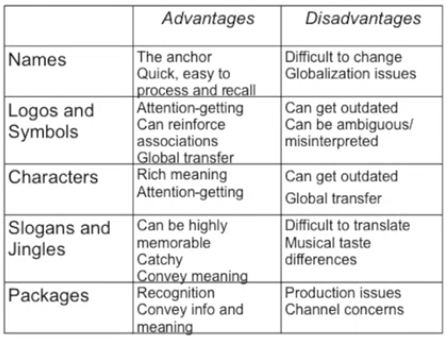
Brand Names
Brand names affect
- Consumers: affects likelihood of purchase;
- Employees: affects morale and productivity;
- Firm: can limit opportunities such as new products and new regions;
- Investors: can cause subconscious judgements about the company’s merits/strength.
There are many types/origins of brand names:
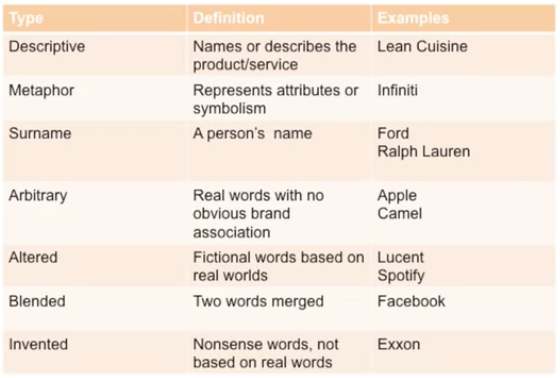
New businesses nowadays use invented words as brand names because most recognizable URLs have already been taken.
When entering a different country, companies either keep their names in original language, such as luxury brands, or translate them into the local language. Translation is tricky as the picked words may mean something else in the language. A few ways are (examples are for the Chinese market):
- Pick characters that mean nothing, like Cadillac;
- Pick characters that sound like the original name but with a meaning close to the brand image, such as Coca-Cola;
- Pick characters that sound farther from the original name but with a meaning closer to the brand name, such as Colgate.
Color
Ultimate goal is to own a color, e.g., Tiffany’s light blue, Mary Kay’s pink. Different viewers experience color differently. it is difficult to ensure consistency of color across platforms/media.
Certain colors can create very strong perceptions. For example, gold, silver, black, white are luxury colors, and blue and pick are gender colors.
There are two axes of color: arousal (stimulating/calming) and affect (whether people like it). The arousal axis is universal while the affect axis varies by culture.
A few examples of color:
- Red: through to stimulate the appetite, also love (passion), excitement;
- Blue: most preferred by men; productive color; curbs appetite;
- Green: tranquility and health; money, nature; fertility;
- Brown: reliability, boredom, practicality, earth;
- White: purity, innocence, empty, spacious (it creates the illusion of space);
- Black: evil, death, mourning, slimming;
- Yellow: bright, gives you energy; been shown to make babies cry; causes eye fatigue;
- Orange: excitement, enthusiasm, warmth, caution;
- Lavender: calms the nerves, relaxation;
- Purple: royalty, wealth, success, wisdom;
- Pink: girl’s color, calming, warm.
Slogans/Taglines
Use a slogan or tagline, derived from brand mantra, can be tailored to a positioning strategy. It can:
- remove some of the ambiguity associated with the brand and/or symbol;
- generate its own equity/emotion;
- reinforce the name or symbol.
Taglines must be short, differentiated from competitors, unique, easy to say or remember. They cannot have any negative connotations especially going across cultures, and it can be protected and trademarked. They should evoke emotional responses.
Packaging
Packaging can influence at the point of purchase and have a continuing influence at the point of consumption. Packaging serves multiple purposes:
- Identify the product;
- Present information (descriptive and persuasive);
- Protect and allow transportation;
- Store;
- Aid consumption.
We should understand that package aesthetics and function are both critical. Not only the package has to grab consumers’ attention in a sea of competing messages, but it also has to work well so that consumers will buy again. Because the distribution channels ultimately present the product to consumers, it is important to know them well.
Persuasion
Another part of the brand identity is to persuade consumers. Persuasion is an active attempt to change belief and attitude. It is a difficult process due to the process is intrinsically biased.
The dominant model is called the Elaboration Likelihood Model. It says there are two routes to persuasion: systematic (central) or superficial (peripheral) processing.
The central route to persuasion says when motivation (involvement), opportunity and ability to process marketing messages are high, the way to persuade them is through “central cues” (or cognitive cues) in messages. The peripheral route to persuasion says when motivation, opportunity, ability or elaboration likelihood is now, focus primarily on “peripheral cues” in messages, which are more automatic reactions, people just make decisions based on these cues.
A few examples of peripheral cues are:
- Classical conditioning: burgers and cokes always go together;
- Consistency: we’ve always done it that way;
- Social proof: everybody’s doing it so it must be good;
- Liking: you like a person, you will like their ideas;
- Authority: just because I say so;
- Scarcity: quick, before they’re all gone.
Brand Repositioning
Brand equity must be actively managed over time. Brand meaning must be reinforced and sometimes adjusted. Reasons for brand change are
- the initial identity/execution was poorly conceived;
- the target is limited;
- it has become out of date.
- it loses its edge, becomes old-fashioned.
- it has just become “tired” or “boring”.
Changes must be consistent with your current brand image; too big of a change will fail to establish the connection to the brand or people feel uncomfortable with the change. The consistency theory says there is a drive to maintain consistency within cognitive systems. Thus, cognitive structures may change in order to increase consistency among elements. Thus, a brand can evolve more gradually to gain more contemporary associations while maintaining familiarity.
- Symbols: can update without changing meaning;
- Brand name: can change to reflect evolving identity;
- Slogans: easier to change than the name;
- New products: can be true to the core identity, but add a modern, innovative element.
Another way is called the butterfly effect. It involves bigger and noticeable changes. The reason to do it is to make it noticeable so people understand and embrace the change.